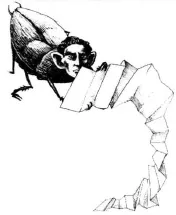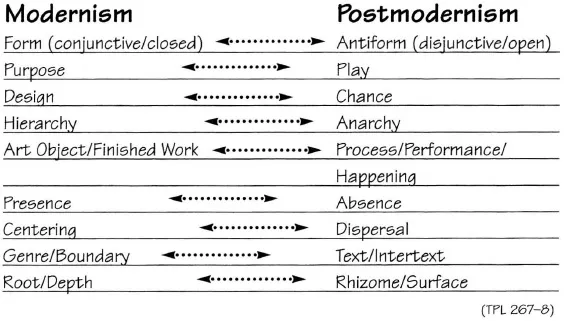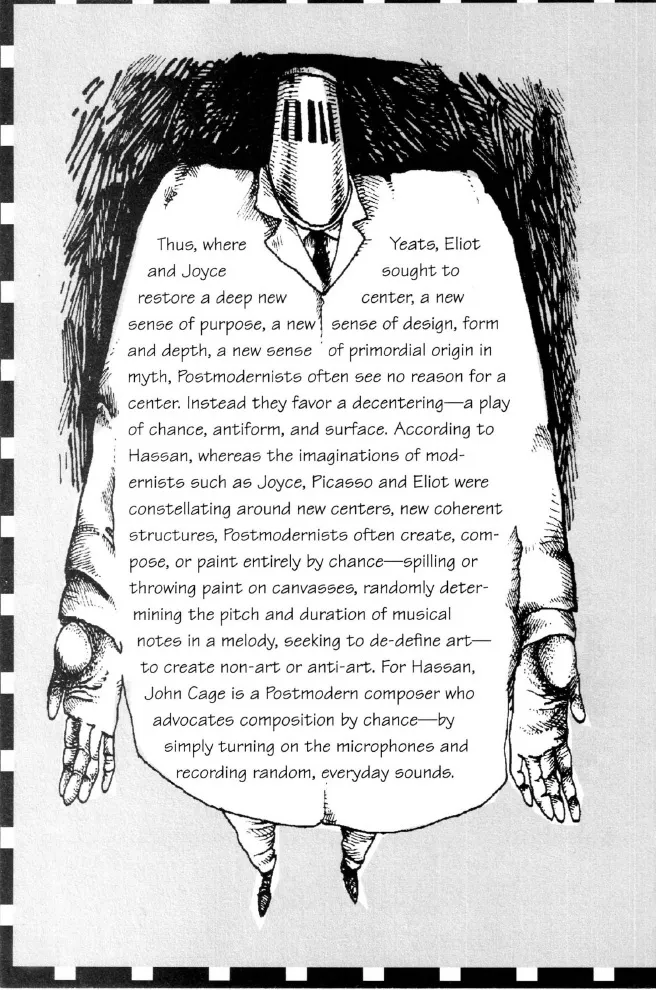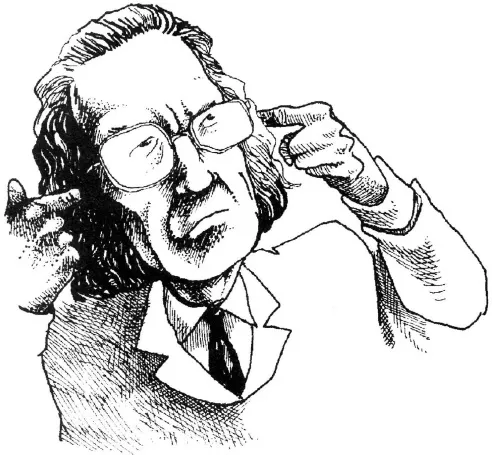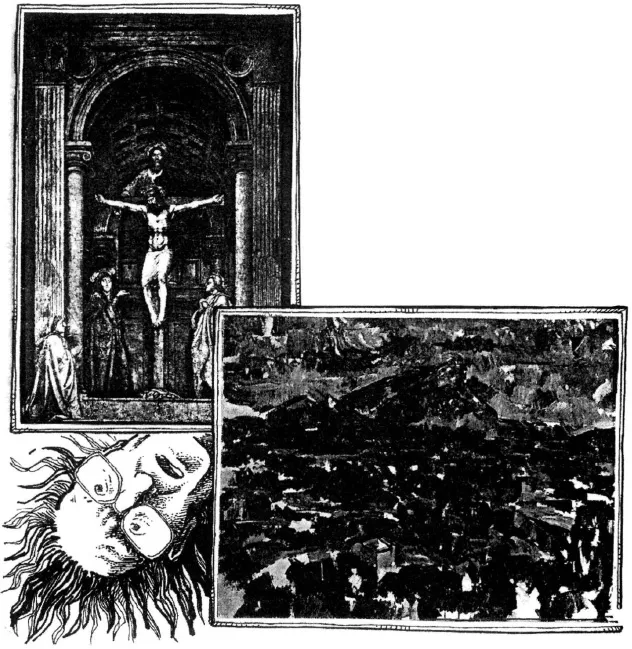![]()
What Is Postmodernism?
Then how does Postmodernism differ from Modernism? There is little agreement on the subject, partly because “Postmodernism”— whatever it is—is an attempt to make sense of what is going on now—and we can see the present clearly only in retrospect.
IHAB HASSAN
One Postmodern theorist, Ihab Hassan, offers a table of differences between the two movements:
It all sounds pretty chaotic. It’s no wonder that we need “map-makers,” intellectuals to chart the depthless new world without a center. Who are some of these “map-makers”? THE MAP-MAKERS
Important Postmodern Thinkers
Jean-Francois Lyotard
Jean-Francois Lyotard was born in France in 1924 and taught in Algeria, Brazil and California, before becoming professor of philosophy at the University of Paris in 1968. In 1985 he became director of the College International de Philosophie.
For some 15 years he was associated with a leftist group called Socialism or Barbarism, which, among other things, criticized Soviet-style communism. Although Lyotard became disillusioned with socialism and Marxism as early as 1964, the events of the student revolt in Paris, in May of 1968, confirmed his unrest.
Discourse, figure
In 1971 we find him beginning a long, post-Marxist period in which he is given to thinking about philosophy, language and the arts. His book Discourse, figure, argues with the concept put forth by Jacques Lacan that the unconscious mind is like a language. Instead, Lyotard suggests that the unconscious is not so much like a language as it is visual and figural, like the figures one draws or paints. Language, after all, is flat, two dimensional. It represses desire. Dreams, on the other hand, are visual, figural, alive with three-dimensional dream figures, and dripping with desire. Like much modern painting, dreams are fragmented. In their attempt to make unconscious material visual, dreams disrupt the kind of linear awareness that language requires. The visual, figure-making nature of the unconscious, though at work within language, disrupts language, disrupts the rational order of language. This is because the figural nature of the unconscious is difficult to represent in language.
The figural resists representation in the same sense that the Holocaust resists representation. At Auschwitz the Nazis would drown out the screams of the victims in the death camps by playing music loudly. Similarly, to attempt to represent Auschwitz in language—to reduce the degradation, death and stench to a concept—drowns out the screams. According to Lyotard, it is therefore necessary that the Holocaust remains immemorial—that it remains being that which cannot be remembered—but also that which cannot be forgotten. Thus, any art attempting to represent the Holocaust should continue to haunt us with its inability to represent the unrepresentable, to say the unsayable. It should continue to haunt us with the feeling that there is something Other than representation.
Lyotard offers the example of Masaccio’s Trinity, painted on the walls of Santa Maria Novella, in Florence, which displays both medieval and Renaissance elements. By attempting to present two impossibly different eras, the painting seems to say that there is always an Other which cannot be truly represented.
Another example Lyotard offers is Cezanne’s Mont Saint-Victoire—a simultaneous attempt to present two different modes of vision: vision with a distinct focal center and vision which is peripheral, diffuse, indistinct. Again, two heterogeneous elements.
Yes. Heterogeneous means “made up of dissimilar elements.”
Poetic metaphor accomplishes the same. When I say “my love is a rose” I am invoking a heterogeneous difference. After all, a rose and my love may have very little in common.
Because all these works of art bring our attention to the Other, to a radical difference, they are political.
The Postmodern Condition
In 1974, the year Postmodern novelist Thomas Pynchon’s Gravity’s Rainbow, won the National Book Award, “streaking” became a fad in the United States, Mama Cass of the Mamas and the Papas choked to death on a sandwich, and a Soviet probe touched down on Mars, Lyotard gained international fame for The Postmodern Condition: a report on knowledge, an account commissioned by the Council of Universities of the Quebec government. The report surveys the status of science and technology, and has become something of a bible of Postmodernism.
Lyotard argues that for the past few decades science has increasingly investigated language, linguistic theories, communications, cybernetics, informatics, computers and computer languages, information storage, data banks, and problems of translation from one computer language to another. He proclaimed that these technological changes would have a major impact on knowledge.
Thus, in 1974 he predicted that no knowledge will survive that cannot be translated into computer language—into quantities of information. Learning will no longer be associated with the training of minds—with teachers training students. For the transmission and storage of information will no longer depend on individuals, but on computers. Information will be produced and sold. Nations will fight for information the way they used to fight for territory. Information will zip around the globe at the speed of electricity, and people will try to steal it. The role of the state will grow weaker. Taking the place of states, huge multinational corporations will dominate.
But having said all this about the direction of scientific knowledge, Lyotard adds that scientific knowledge is not the only kind of knowledge. His interest, it turns out, is not so much in scientific knowledge and the scientific method, per se, but in how scientific knowledge and method legitimize themselves—how they make themselves believable and trustworthy. And at this point Lyotard makes a distinction between scientific talk and narrative talk. Of course he doesn’t use the word “talk.” He uses scientific “discourse” and narrative “discourse.”
Yes. I will give you some examples that Lyotard does not use, but which help explain his theory. When members of the Winnebago tribe sit around a fire and h...


